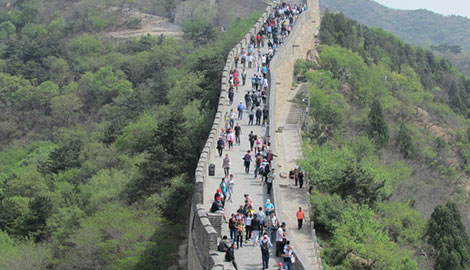 |
|
Tourist at the great wall of China PHOTO: COURTESY |
China, Kenya: Everyday, thousands of tourists, mainly locals, brace themselves to climb a section of the Great Wall of China.
It is a spectacle to behold as everybody; the old, the young and even the physically challenged, queue to pay homage to one of the world’s greatest wonders.
“Christians go to Israel, Muslims go to Mecca, men go to Phuket (Thailand). But for Chinese, we climb the Great Wall,” Mr Li, an elated Chinese man tells me.
Most tourists walk in groups behind a leader waving a flag, who occasionally stops to give short lectures on each section over a microphone and tiny speakers mounted on a belt.
However, there are also some tourists who prefer to tour the place without a guide.
The Great Wall of China was listed as a World Heritage site by the United Nations Educational Scientific and Cultural Organisation in 1987 and accounts for the lion’s share of income generated by the tourism industry.
Last year, the tourism sector alone, pumped in $18 billion to the world’s second largest economy as reported in the Tourism Industry Report 2013-2017. However, 93 per cent of the tourists are domestic, accounting for over 87 per cent of the revenue collected in the sector.
“Over 8 million tourists visited this section of the Great Wall last year alone. Only 1 million were foreigners,” Ms Zhang Suzhi, the Deputy Governor of Yangqi County who accompanied me on the trip, said, adding that domestic tourists have pushed the sector to great heights.
A ticket to tour the Great Wall is sold under $7 (Sh600) at the gate, and is standard for both Chinese citizens and foreigners. Those over 60 years old, as well as students, pay half the amount while the disabled and minors access the Great Wall for free.
Previously, the fees for accessing most tourist sites in China, was up to 15 times more for foreigners as compared to the locals. But since the idea of opening up China to the rest of the world was adopted by the ruling Communist Party, the fee has been standardised.
Soldiers and peasants
The back of the ticket reads ‘Bu dao Changcheng, fei hao han’ (If you have never been to the Great Wall, you are not a true Chinese) a famous line from Mao Zedong, popularly referred to as Chairman Mao.
He still holds a lot of influence over the Communist Party of China and Chinese nationals today, having been the founding father and chairman of the party for 27 years. His body lies in State at the Beijing National Museum.
The Great Wall stretches approximately 8,851.8km from the east to the west of China, crossing 156 counties.
The Great Wall was built from the 3rd century all the way to the 17th by different dynasties in China. Some sections have therefore long collapsed and are non-existent. Built by mainly soldiers and peasants, over 1 million of them died during its construction and were buried right inside the wall itself. The wall was supposed to protect China from external invasions.
Stay informed. Subscribe to our newsletter
 The Standard Group Plc is a
multi-media organization with investments in media platforms spanning newspaper
print operations, television, radio broadcasting, digital and online services. The
Standard Group is recognized as a leading multi-media house in Kenya with a key
influence in matters of national and international interest.
The Standard Group Plc is a
multi-media organization with investments in media platforms spanning newspaper
print operations, television, radio broadcasting, digital and online services. The
Standard Group is recognized as a leading multi-media house in Kenya with a key
influence in matters of national and international interest.
 The Standard Group Plc is a
multi-media organization with investments in media platforms spanning newspaper
print operations, television, radio broadcasting, digital and online services. The
Standard Group is recognized as a leading multi-media house in Kenya with a key
influence in matters of national and international interest.
The Standard Group Plc is a
multi-media organization with investments in media platforms spanning newspaper
print operations, television, radio broadcasting, digital and online services. The
Standard Group is recognized as a leading multi-media house in Kenya with a key
influence in matters of national and international interest.








